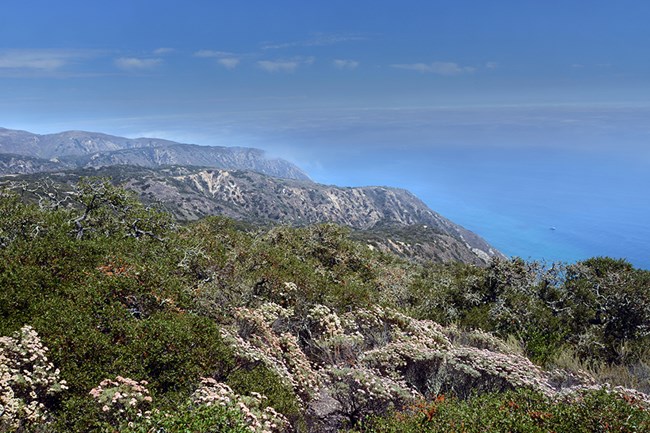
NPS/Reuven Bank Channel Islands National Park has a Mediterranean-type climate, characterized by cool, wet winters with average annual rainfall of 8-40 inches and hot, dry summers. The climate is moderated by the surrounding sea, which in the summertime provides lower temperatures, higher humidity, and more frequent nocturnal fog compared to the mainland. Human impacts on our climate have already had local effects on the islands. The average annual temperature within park boundaries increased by almost two degrees Fahrenheit from 1895 to 201610. A large variety of vegetation communities call the Channel Islands home, including grasslands, coyote brush shrubland, island oak cloud forest, scrub oak forest, riparian areas, conifer forest, maritime chaparral, coastal chaparral, dune communities, coastal bluff scrub, and more. Since the park’s climate is buffered by the ocean, the impacts of rising temperatures may be somewhat mitigated on the islands compared to state-wide climate models, especially on Anacapa Island, the smallest of the Channel Islands. Therefore, it is difficult to predict how changing climate will impact the plant and animal species in each of these communities. However, research has shown that for some rare plants, such as the endangered soft-leaved paintbrush, hotter growing-season temperatures reduce growth, indicating a sensitivity to continued climate change 11. Additionally, some rare plants have seeds that rely on cold weather cues to germinate 12, so increases in nighttime temperature and prolonged hotter and drier periods could affect these species’ abundance. 
NPS/Reuven Bank Other climate factors may have a more outsized effect on the park’s terrestrial and intertidal communities. Santa Ana winds, wind events that start inland and move outward towards coastal Southern California and the Channel Islands, are correlated with warmer and drier island conditions. Scientific studies indicate that extreme weather events are likely to become more frequent and intense due to human-caused climate change 13. While future models of Santa Ana wind patterns are not conclusive, more extreme or frequent Santa Ana winds would further stress island communities. For instance, rockweeds, which are foundational species in intertidal ecosystems, have shown dramatic declines correlated with previous prolonged Santa Ana wind events. A change in moisture availability is one of the most profound potential impacts on the Channel Islands’ terrestrial ecosystems. Before European settlement, the high, fog-drenched ridge that dominates central Santa Rosa Island was covered with a "Cloud Forest14"—a forest of tall oak and pine groves growing out of a cover of shorter chaparral plants, named for the fog that it needs to survive. The trees and plants here harvest water from the heavy fog that regularly rolls across the island and condenses on leaves and twigs, eventually dripping to the ground like rain. Beginning in the mid-1800s, grazing by non-native animals like sheep, feral pigs, cattle, horses, deer, and elk eliminated most of this cloud forest, along with over 75% of the entire island's native vegetation. Unpublished preliminary analysis from long-term monitoring of park vegetation communities on all five park islands from 1984 to 2018 suggests that diversity and cover of vegetation communities are significantly affected by moisture availability and that plant communities in drier areas in the park are recovering from the effects of ranching more slowly. Although the future effects of climate change on moisture availability at the Channel Islands is uncertain, The National Park Service and U.S. Geological Survey are actively working to restore both this unique cloud forest ecosystem and other native island plant communities with the potential for decreased drier conditions in mind. 
Tim Hauf, timhuafphotography.com Drier, hotter conditions could also increase the prevalence of wildfires on the Channel Islands. While fire is a natural component of the islands’ ecosystems, the rate of fire return is much slower in the park compared to the mainland. For California as a whole, burned area increased about 500% annually and 800% during summer from 1972 to 201815, increases that statistical analyses have shown are most closely related to human-caused climate change. Overall, wildfire activity is lasting longer and becoming more extreme – a trend resulting in the term “fire year,” which is used to define it as a year-round occurrence. These wildfires become difficult to manage and can threaten ecosystems, people, and vulnerable infrastructure. More intense and more frequent fires could cause lasting changes to island ecosystems.
|
Last updated: August 22, 2023
